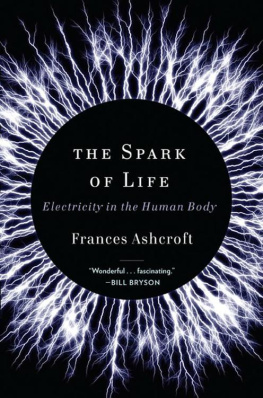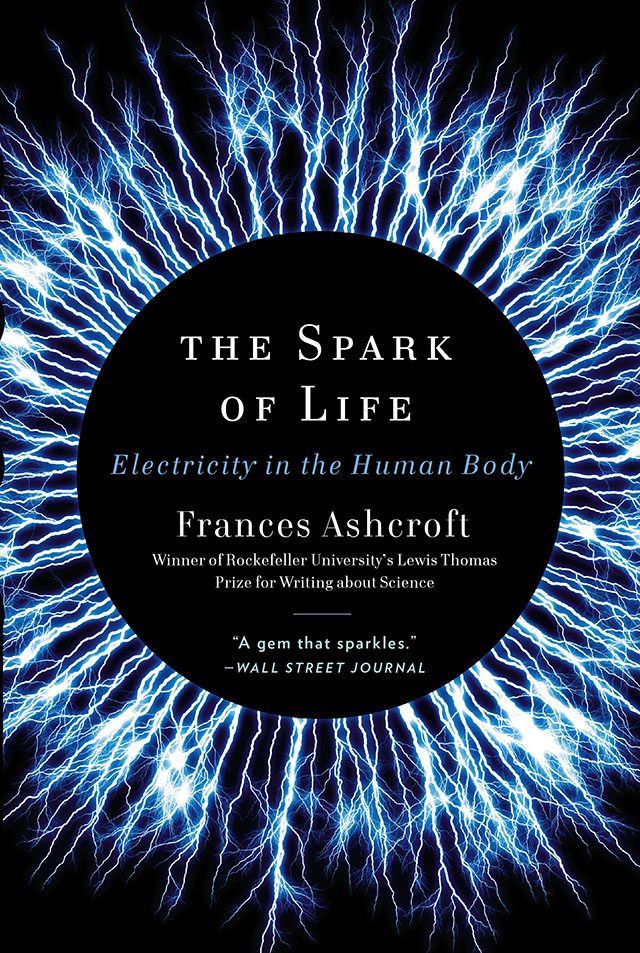
The Spark of Life
Electricity in the Human Body
FRANCES ASHCROFT
Line drawings by Ronan Mahon

W. W. Norton & Company
New York London
For Rosy and Charles
Man is no more than electrified clay
Percy Bysshe Shelley
Contents
Cautionary Note
Electricity is highly dangerous when used incorrectly. The reader is strongly advised not to try any of the experiments described in this book on themselves, on others, or on animals. The author and publishers accept no responsibility for any resulting harm if the reader should fail to heed this advice.
Introduction
I Sing the Body Electric
Then felt I like some watcher of the skies
When a new planet swims into his ken;
Or like stout Cortez when with eagle eyes
He stard at the Pacific and all his men
Lookd at each other with a wild surmise
Silent, upon a peak in Darien.
John Keats, On first looking into Chapmans Homer
When he was just a few months old, James suddenly developed diabetes so severe that he required hospitalization. He faced a lifetime of insulin injections. Over the course of the next few months it became clear that he was also developing more slowly than most children and that he had problems with walking and talking. By the time he was five years old, he had only just started to walk, he was still unable to communicate and he had the temper tantrums of a two-year-old. Life was far from easy for his anxious parents.
It was later discovered that James has a very rare form of diabetes caused by a genetic defect (a mutation) in a protein known as the K ATP channel that is important for both insulin secretion and brain function. Some mutations in the K ATP channel simply cause diabetes, but around 20 per cent of them, including the one James has, also produce a constellation of neurological difficulties, including developmental delay, hyperactivity, behavioural problems and muscle dysfunction. All of these symptoms arise because the K ATP channel influences the electrical activity of the insulin-secreting cells as well as that of the muscles and brain. It turns out that Jamess story is closely entwined with my own, for the K ATP channel has been my lifes work and understanding how it operates has enabled James to replace the multiple daily insulin injections he once needed to control his diabetes with just a few pills.
Diabetes occurs when the beta-cells of the pancreas do not release enough insulin for the bodys needs, so that the blood sugar level rises. Back in 1984, I discovered that the K ATP channel sits in the membrane that envelops the beta-cell and regulates its electrical activity and thereby insulin release. The channel functions as a tiny, molecular pore that is indirectly opened and closed by changes in the blood sugar concentration: when the pore is closed insulin secretion is stimulated and when it is open insulin release is inhibited.
I vividly remember the day I made that discovery. As so often happens, the breakthrough came late at night when I was working alone. I had hypothesized that adding glucose to the solution bathing the beta-cells would cause the channel to shut. Yet when it did, I felt certain it must be a technical error. So certain, in fact, that I almost ended the experiment. But just in case I was wrong, I tested the effect of removing the sugar, reasoning that if glucose were indeed regulating the channel activity its removal should cause the pore to reopen, whereas if it were simply a technical problem the channel should remain closed. After several agonizingly long minutes the channel opened once again. I was ecstatic. I was dancing in the air, shot high into the sky on the rocket of excitement with the stars exploding in vivid colours all around me. Even recalling that moment sends excitement fizzing through my veins, and puts a smile on my face. There is nothing nothing at all that compares to the exhilaration of discovery, of being the first person on the planet to see something new and understand what it means. It comes all too rarely to a scientist, perhaps just once in a lifetime, and usually requires years of hard grind to get there. But the delight of discovery is truly magical, a life-transforming event that keeps you at the bench even when times are tough. It makes science an addictive pursuit.
That night I felt like stout Cortez, silent upon his peak in Darien, gazing out across not the Pacific Ocean, but a landscape of the mind. It was crystal clear where my mental journey must take me, what experiments were needed and what the implications were. Next morning, of course, all certainty swept away, I felt sure my beautiful result was merely a mistake. There was only one way to find out. Repeat the experiment again and again and again. That is the daily drudgery of a scientific life: it is very far from the ecstasy of discovery.
Even all those years ago, it was obvious that if the channel failed to close when the blood glucose level rose, insulin secretion would be prevented and the result would be diabetes. To prove it, we needed to find mutations in the DNA sequence that encodes the K ATP channel protein in people with diabetes. It took ten years of work by many people throughout the world to identify that DNA sequence, and when we finally screened it for mutations we found... nothing!
It was my friend Andrew Hattersley who eventually found the first mutations, another ten years later. Andrew is a very special person. Tall, slim and sandy-haired, with an incisive mind and a warm compassionate nature, he is both a wonderful doctor and a brilliant scientist. He not only recognized that the mutations we were seeking would be more likely to be found in people who were born with diabetes (rather than those who developed it later in life); he also instigated a worldwide search to find them. When he and his associate Anna Gloyn identified the first mutation in 2003, he phoned me and invited us to collaborate with him. It was a call I will never forget.
Working together, we showed that the K ATP channel mutations cause diabetes because they lock the channel permanently open, preventing electrical activity and insulin secretion. Even more excitingly, we found that the defective channels can be shut by drugs known as sulphonylureas that have been safely used for more than fifty years to treat type 2 (adult-onset) diabetes and which we already knew closed normal K ATP channels.
In the past, patients who were born with diabetes were treated with insulin injections, as their symptoms suggested they had an unusually early-onset form of type 1 (juvenile) diabetes. In this disease the beta-cells are destroyed by the body itself and lifelong insulin is essential. Thus James and others like him were not given drugs, but immediately started on insulin. Our research suggested that instead such patients could be treated with sulphonylurea tablets and to everyones delight the new therapy not only worked, but actually worked much better than insulin. Over 90 per cent of people with neonatal diabetes have been able to make the switch.
It is a rare privilege for a research scientist to see ones work translated into clinical practice, and even rarer to meet the people whose lives have been affected, so I have been extremely fortunate. Words cannot convey the extraordinary emotional experience of meeting the children and families whom your work has helped. To have, for example, a pretty young teenager turn to you and say Thanks to you I can wear a dress. Why? I inquired, puzzled. Because, she replied, I no longer need a skirt or trouser waistband from which to hang my insulin pump. An insulin pump, I quickly appreciated, is something of a constraint. Dashing in and out of the waves in the summer sea is simply not possible each time the pump must be removed and reattached and its bulky shape ruins the line of figure-hugging clothes. Drug therapy obviates these problems and banishes painful injections. But it also has more important benefits. For reasons still unclear (but which we are of course exploring), sulphonylureas produce a far more stable blood glucose level than insulin. Dramatic fluctuations in blood sugar become a thing of the past, and hypoglycaemic attacks are much less frequent (and in some cases virtually vanish). Unexpectedly, the average blood sugar level also decreases so that the risk of diabetic complications (kidney disease, heart disease, blindness and amputations) is reduced.
Next page



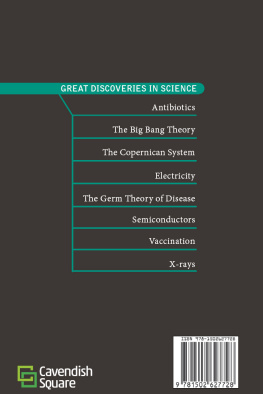
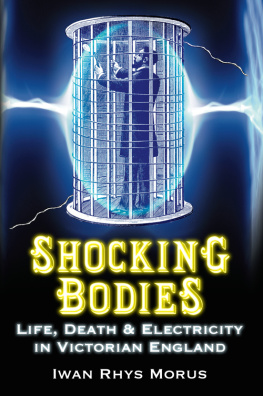

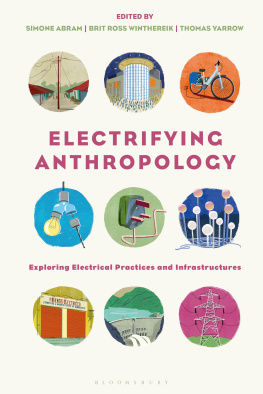
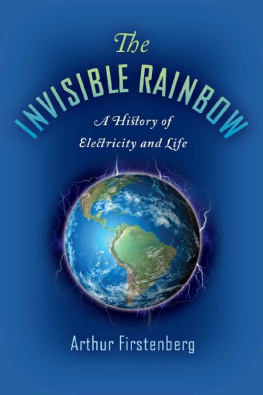
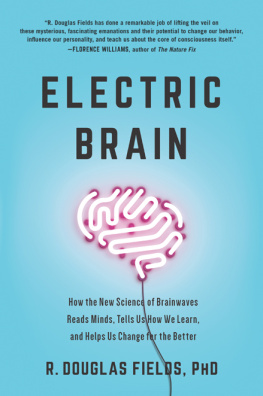

![Frances M. Ashcroft - Life at the Extremes: [The Science of Survival]](/uploads/posts/book/49583/thumbs/frances-m-ashcroft-life-at-the-extremes-the.jpg)
